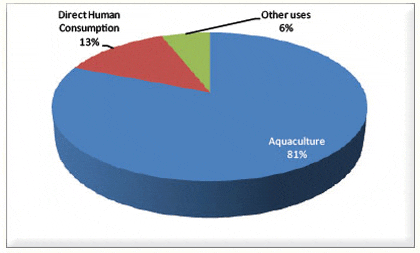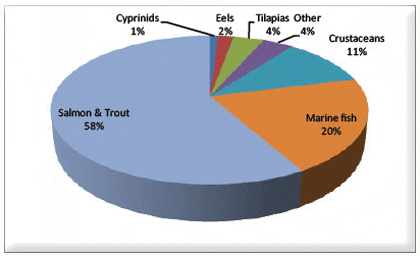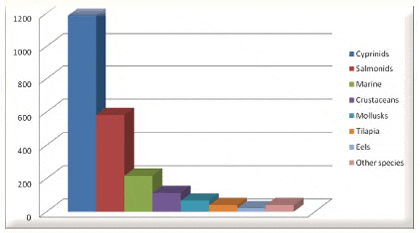A recent FAO/WHO expert consultation (Joint FAO/WHO Expert Consultation on the Risks and Benefits of Fish Consumption (2011) available at: www.fao.org/docrep/014/ba0136e/ba0136e00.pdf) concluded that fish in the diet of women giving birth to children lowers the risk of suboptimal development of the brain and neural system compared to children of women not eating fish.
Strong evidence also underlines how consumption of fish, and in particular oily fish, lowers the risk of death (36 per cent reduction) caused by coronary heart diseases (CHD) - a particularly growing health problem in developing countries.
A daily intake of only 250 mg EPA+DHA per adult gives optimal protection against CHD. For optimal brain development in children, the daily requirement is only 150 mg. Evidence on the role DHA has in preventing mental illnesses is now becoming more and more convincing. This is particularly important as brain disorders are dramatically increasing all over the world, and in the developed nations, the cost related to mental disorders is now greater than the cost related to CHD and cancer combined.
As with humans, most fish need to get EPA and DHA through their diets. This is particularly true for fish from the marine environment where marine algae are the main producers of these valuable fatty acids ending up in our food chain. Freshwater fish seem to be better able to elongate short chained omega-3 fatty acids into EPA and DHA.
Farmed fish, and particularly marine fish, need to be provided the beneficial EPA and DHA fatty acids through their feed. This will secure a final product comparable and as healthy as their wild counterparts. Fish oil is in practice the only economically viable source of these essential fats for feed purposes, and around 80 per cent of all fish oil is consumed by the aquaculture sector (Figure 1). However, this amount seems to be going down despite the growing aquaculture production, as the demand for fish oil for direct human consumption is rapidly increasing.

Let’s take a closer look at the total consumption of these essential omega-3 fats (EPA+DHA) by the aquaculture sector. The global production of fish oil is around 1 million tonnes/yr, and is not expected to increase. Every year roughly 800 000 tonnes of pure fish oil are used for aquaculture feed. The level of EPA+DHA in fish oil is usually between 15 and 25 per cent , so with an average content of 20 per cent we would expect 160 000 tonnes EPA+DHA from fish oil to fish feed purposes. Additionally, fishmeal provides 50 000 tonnes EPA+DHA for fish feed (based on 3.1m tonnes fish meal containing 8 per cent oil). At present, the aquaculture sector therefore consumes an estimated total of 210 000 tonnes of EPA+DHA, all originating from the marine environment. Figure 2 shows how the total amount of EPA+DHA is consumed by the different groups of farmed species.
Salmon and trout (salmonids) farming alone uses 122 000 of the 210 000 tonnes EPA+DHA provided annually. In 2010, production of salmonids was 2.4 million tonnes; 1.6 million tonnes salmon and 0.8 million tonnes trout. Based on recent nutrient composition data for Atlantic salmon and Rainbow trout, which represent about 90 per cent of all farmed salmonids, the EPA+DHA content in salmon and trout is estimated at an average 22 g/kg fish, providing 53 000 tonnes of EPA+DHA. This estimate shows that 43 per cent of the essential EPA+DHA fats from feed are retained in the fish.
This is in line with commercial feed producers claiming 50 per cent of fish oil is retained, and scientific studies showing retention of EPA+DHA in salmon from 30-75 per cent depending on the level of fish oil in feed; lower levels of fish oil give higher retention rates.
Since salmonids consume a major part of fish oil in aquaculture, the EPA+DHA retention rate of 43 per cent is used for calculating the contribution of these essential fatty acids for other species consuming fish oil, although one would expect better retention in fish having a diet with lower levels of fish oil. Cyprinids do not get fish oil in their diets, but some fishmeal adds some limited amount of EPA+DHA to their feed (Figure 2). However, with an annual production of 24 million tonnes carps, they contribute around 108000 tonnes of EPA+DHA, assuming a level of EPA+DHA of 4.5 g/kg of fish (calculation based on literature values for common carp, Silver carp, Catla, and Crucian carp). Mollusks are not consumers of feed, but are net providers of EPA+DHA with an estimated contribution of 6 000 tonnes.

Based on the assumptions above, the aquaculture sector as a whole provides 206 000 tonne of EPA+DHA, but at the same time consumes a total of 210 000 tonnes; i.e., in practice providing the same amount as it consumes. Figure 3 shows the major farmed species providing long-chained omega-3 to our diets. At present the aquaculture sector provides enough EPA+DHA to cover the need of more than two billion people. All carps combined consume less than 1 per cent of all EPA+DHA provided by fish oil and fishmeal, but contributes more than 50 per cent of all the EPA and DHA coming from aquaculture products.
Alternatives such as EPA and DHA production based on microalgae is too costly, and from an economic point of view not a viable alternative. Researchers have reported that plant based oils can have a 15 per cent DHA content from genetically modified plant seed oil. However, ingredients based on genetic modified plants are not yet widely accepted as feed ingredients. Despite this, with the increasing focus on reducing levels of fish oil and fish meal in diets for aquaculture, the sector is soon a net provider of these valuable and essential fatty acids to our diets.

May 2013




